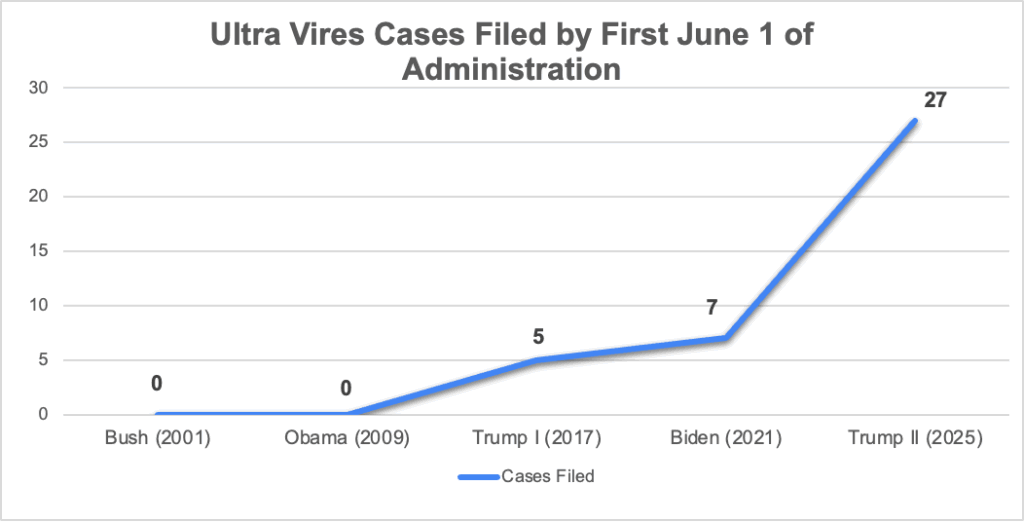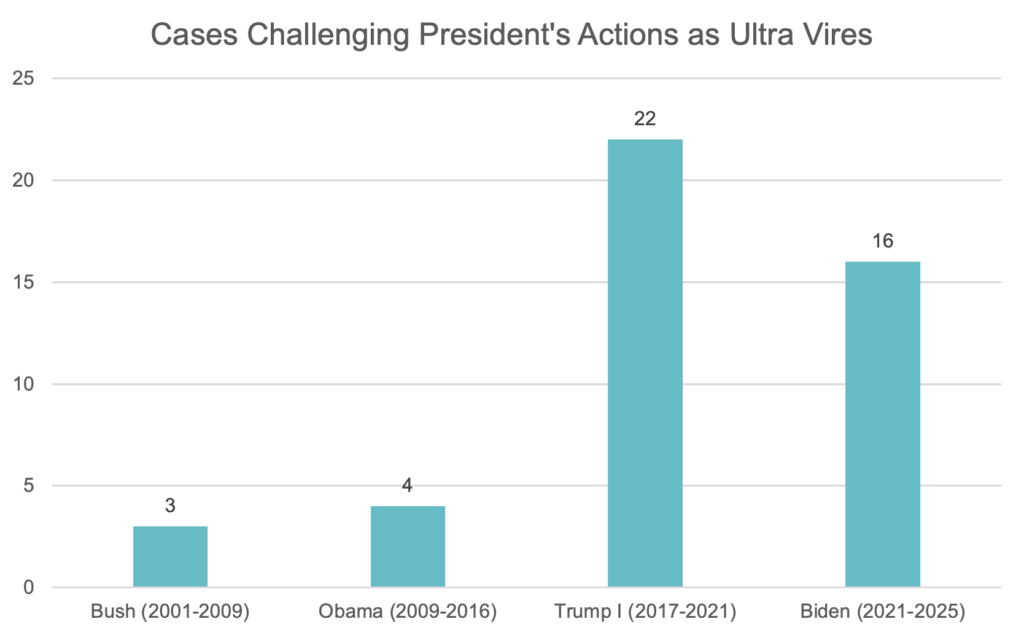Since 2016, presidents and their administrations have increasingly drawn lawsuits arguing that they are overstepping their authority. In these ultra vires claims, litigants contend that presidential actions—including, for example, executive orders, proclamations, or memoranda, as well actions by executive agencies done at the President’s behest—exceed the scope of the authority granted to the President by the Constitution and/or by statutes.
Actions in the first week of the second Trump administration—along with the challenges that followed—provide a case in point. During that first week alone, the President signed 37 executive orders, several of which gutted existing climate, energy, and environmental policies, including Executive Order 14154, Unleashing American Energy and Executive Order 14156, Declaring a National Energy Emergency. On April 8, 2025, President Trump also signed Executive Order 14261, Reinvigorating America’s Beautiful Clean Coal Industry and Amending Executive Order 14154. A series of lawsuits have challenged parts of these orders, including one filed on May 29 that directly poses the question of whether those three executive orders are unlawful, unconstitutional, and ultra vires. In that case—Lighthiser v. Trump—a group of youth plaintiffs argue that by issuing these executive orders the President has contravened Congress’ mandates to EPA, exceeded the authority delegated to him by Congress under Article I, and failed to faithfully execute the law under Article II.
This blog post describes trends in pending or closed cases going back to 2000 for which (1) an ultra vires claim was raised against the Executive and (2) there is an order issued in which the ultra vires claim was either material to the outcome of the case or the claim was closely examined by the court, even if not the basis of the court’s decision. Claims like these have risen sharply since 2016, coinciding with the first Trump administration. Ultra vires claims in cases that address climate and environmental issues have increased following the same pattern.
Figure 1.
We analyzed cases where plaintiffs brought ultra vires claims against the Executive Branch—either the President or an agency carrying out presidential directives—for actions in excess of either constitutionally- or statutorily-derived authority, or both. Typically, a plaintiff may bring a lawsuit directly against the President by raising an ultra vires claim, or against an executive agency by bringing a claim under the Administrative Procedure Act (APA). APA claims cannot be brought against the President but APA Section 706(2)(C) gives courts jurisdiction to “hold unlawful and set aside agency action, findings, and conclusions found to be … in excess of statutory jurisdiction, authority, or limitations, or short of statutory right.”
As shown in Figure 1, the number of cases that meaningfully consider an ultra vires claim(s) during the Bush and Obama administrations is dwarfed by the first Trump administration. The number of ultra vires cases over four administrations, from 2000 to 2015, make up less than half of cases brought during President Trump’s first term. Indeed, the first Trump administration marks a categorical shift in the number of ultra vires claims brought and meaningfully considered by the courts. And the number of ultra vires cases filed appears to be rapidly accelerating in the second Trump administration. In the early days of President Trump’s second term, the number of lawsuits in which plaintiffs are bringing ultra vires claims against the executive branch is significantly outpacing that of any other presidential administration in recent history, as shown in Figure 2.
Figure 2.
Recent cases raising ultra vires claims broadly fall into three categories: (1) cases where the President asserts their inherent constitutional authority to take a particular action, (2) cases in which the President acts pursuant (or contrary) to an express or implied statutory authorization from Congress, and (3) cases in which a federal agency is alleged to have exceeded its statutory authority.
Claims Again the President
Even as the number of cases filed has increased, the analyses that courts apply to ultra vires claims have remained largely unchanged during this period. As explained by the Supreme Court in 1952, the President’s authority to act “must stem either from an act of Congress or from the Constitution itself.” Youngstown Sheet & Tube Co. v. Sawyer, 343 U.S. 579, 585 (1952).
In Youngstown, the Supreme Court ruled that President Truman did not have the power to seize the country’s steel mills. The Youngstown framework articulated in Justice Robert Jackson’s concurring opinion has become the accepted framework through which courts review executive action. It addresses the first two types of actions we examine here: those that the President takes. First, for cases in which the President has no statutory basis to act and instead claims inherent authority, courts have concluded that “‘congressional inertia, indifference or quiescence may’ invite the exercise of executive power.” Youngstown, 343 U.S. at 637 (Jackson, J., concurring). Courts reviewing actions of this kind undertake a “complicated” analysis of “all the circumstances which might shed light on the views of the Legislative Branch toward such action”—and may deem Congress’s decision not to restrict the President as permission; and Congress’s failure to react after presidential action a ratification. Dames & Moore v. Regan, 453 U.S. 654, 668 (1981).
Second, for cases in which the President claims there is some degree of express or implied Congressional authorization for a challenged action, courts’ approaches vary. Where the President is carrying out something Congress authorized and that is consistent with Congress’s will, the President’s authority is “at its maximum,” since it includes both the President’s own authority and Congress’s by delegation. Conversely, where the President is acting contrary to a congressional authorization, their “power is at its lowest ebb” and the courts can only affirm that power where a given action is “within [the President’s] domain and beyond control by Congress.” Id. at 637, 640.
Further, some Presidential actions are not subject to judicial review at all—for example, where statutes give the President discretion to make a finding or determination that then triggers a statutory authority to act in response to that finding. Some of the latter actions may otherwise be subject to judicial review, but the initial, usually-discretionary step of triggering a conditional delegation of authority is often unreviewable. Dalton v. Specter, 511 U.S. 462, 477 (1994).
Figure 3.
APA Claims
For ultra vires claims against a federal agency, APA Section 706(2)(C) gives courts jurisdiction to “hold unlawful and set aside agency action, findings, and conclusions found to be … in excess of statutory jurisdiction, authority, or limitations, or short of statutory right.” When a federal agency is alleged to have acted ultra vires, courts must determine whether the action exceeds statutory authority. To do this, courts compare the action that is claimed to be excessive with the power Congress has delegated the agency to act under to assess whether the agency remained within the bounds of its statutory grant of authority when taking the challenged action. And since the Supreme Court’s 2024 decision in Loper Bright overturned Chevron, federal courts have an even stronger role in interpreting whether an agency’s action comports with its statutory authority.
Ultra Vires Cases in the Second Trump Administration
The rapid increase in ultra vires claims filed against the second Trump administration may create more opportunities to apply and potentially to further develop these tests. The sheer number of cases included in our study—27 cases against this administration so far, with 13 of those cases specifically challenging President Trump’s own actions (plus 40 more cases which raise ultra vires claims but do not yet meet our criteria for inclusion because there have been no relevant court orders)—suggests that this is an area of law to watch. Two cases filed in the early days of the second Trump administration highlight the kinds of actions being challenged and the way litigants are framing their claims.
First, Metropolitan Transportation Authority (MTA) v. Duffy challenges the Federal Highway Administration’s (FHWA) attempts to terminate the congestion pricing program in New York City, which has already successfully reduced congestion and related emissions. The program is created by state law but involves federal highways, so it requires certain federal permissions. New York previously entered into an agreement with the FHWA that authorized the program but, on February 19, 2025, the Department of Transportation issued a letter purporting to terminate that agreement and revoke the congestion pricing program’s federal permissions. New York’s Metropolitan Transit Authority (MTA) responded with a lawsuit seeking to invalidate the agency’s termination.
Federal regulation imposes restrictions on agencies’ ability to terminate their agreements. The regulation authorizes an agency to unilaterally terminate under two circumstances, but only if those two grounds for termination are specified in the agreement itself. FHWA’s agreement failed to specify any grounds for termination. Accordingly, the court determined that the MTA is likely to succeed on the merits of its APA section 706(2)(C) claim that unilaterally terminating this agreement was in excess of the FHWA’s authority under that regulation. On May 28, 2025, the court issued a preliminary injunction preventing the federal defendants “from taking any agency action founded on the February 19, 2025 letter” while the litigation is pending.
Second, Northern Alaska Environmental Center v. Trump challenges President Trump’s Executive Order 14148, Initial Rescissions of Harmful Executive Orders and Actions. In the Order, President Trump purported to rescind President Biden’s previous withdrawals of certain areas of the U.S. Outer Continental Shelf from eligibility for future oil and gas leases pursuant to Section 12(a) of the Outer Continental Shelf Lands Act (OCSLA). Environmental organization plaintiffs claim that the rescission “exceeds [President Trump’s] constitutional authority and his statutory authority under OCSLA and is therefore ultra vires and unlawful.”
Northern Alaska Environmental Center does not yet have any orders in which the court considers the ultra vires arguments but is nonetheless notable, even at this early stage. In many instances, plaintiffs will raise an ultra vires argument among several other claims, creating an opportunity for courts to resolve the dispute on other grounds and not necessarily address the ultra vires claims. In Northern Alaska Environmental Center, the constitutional and statutory ultra vires claims are the only ones raised in the complaint. We are, thus, more likely to see the court consider the ultra vires issue directly here. (This case is not included in the case totals described above.)
Conclusion
There has been a dramatic increase in the number of cases in which plaintiffs allege that the President—either by their own actions or through an agency—is exceeding constitutional and/or statutory authority. The increase might be attributable to attempted expansions of executive power, changes to plaintiffs’ litigation strategies, or a host of other factors.
Plaintiffs in cases that broadly challenge executive action face an uphill battle in showing particularized injuries and in framing their controversy in terms that avoid courts deeming it a non-justiciable political question. Courts often do not reach the merits of these cases but rather dismiss them at the preliminary stages, for example, for plaintiffs lacking standing, for the claims being unripe or moot, or by avoiding the core issue as a political question not appropriate for adjudication. We plan to undertake further work to analyze how often courts ruled for the plaintiffs on the merits of the ultra vires claim, for the plaintiffs on some other claim, or where courts ruled for defendants.
What is clear from this initial review is that the overall quantity of these cases has increased dramatically since 2000. And as a result—even with the Supreme Court’s decision in Trump v. CASA, Inc. significantly limiting courts’ power to issue nationwide injunctions—the large number of ultra vires cases now being filed will provide courts ample opportunity to continue applying, refining, and expanding on existing precedent to better clarify which kinds executive actions are permissible.
Great Job Vincent Nolette, Olivia Guarna and Daniel J. Metzger & the Team @ Climate Law Blog Source link for sharing this story.







